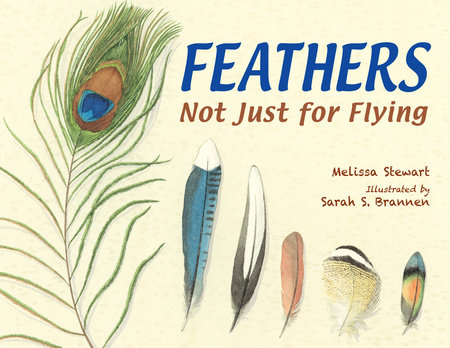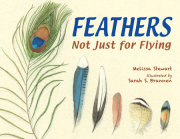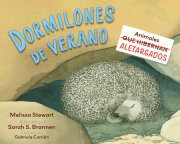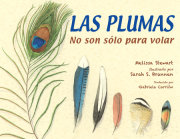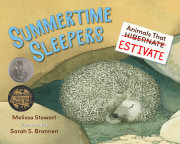*Feathers are not only a means of avian locomotion—they also have many secondary purposes for birds. “Feathers can warm like a blanket... or cushion like a pillow,” writes Stewart. “Feathers can shade out sun like an umbrella... or protect skin like sunscreen.” Making skillful use of trompe l’oiel, Brannen’s delicate, refined watercolors give the project the feel of a birders’ scrapbook, as though the feathers, “photographs,” informational notes, and other ephemera that appear have been taped, stapled, and clipped to the pages (one note even has a telling coffee cup stain). A focused and thorough examination that highlights the striking beauty of these often-unnoticed natural objects.
-Publishers Weekly, *starred review
An album of images and a simple text reveal that birds' feathers are far more versatile than one might expect. Comparing feathers to familiar objects, Stewart reveals that birds use them in surprising ways. Her two-level text is headlined with a comparison and includes a short paragraph of explanation. Laid out like a scrapbook, her words share a page or spread with accurate and appealing watercolor images of a bird (identified by species and location), the everyday object in question and the feather. From backyard blue jays and cardinals to exotic manakins and peacocks, the 16 birds used as examples come from all over. The rosy-faced lovebird in Namibia carries nesting material in its tail feathers, like a forklift. For the Alaskan winter, a willow ptarmigan grows feathers on its feet that serve as snowshoes. In Mongolia, a Pallas' sandgrouse uses his spongelike belly feathers to soak up water to bring to his nestlings. On a concluding spread, text and illustrations together provide an example of one possible system of feather classification. Sepia-toned endpapers show some of the feathers described. Other than a note about Birdwatching magazine, the author doesn't indicate her sources, but considerable research by both author and illustrator is evident.
The combination of thoughtful approach and careful crafting makes this an excellent resource for early nature study.
-Kirkus Reviews
Compact, consistent entries, most set in attractively composed double-page spreads, focus on the many ways in which birds benefit from their feathers. Some uses are not too surprising, such as the wintry Maine blue jay's feathers that "trap a layer of warm air next to its skin" or the peacock's glorious feathers that help him attract a mate. The book, though, also features plenty of feather utilities that kids (and adults) may not have known or carefully considered, such as the club-winged manakin's ability to make "squeaky chirping little trills" with its curved and ridged feathers, or the spongy feathers of the Pallas' sandgrouse, who uses them to bring water to his nesting chicks. Each bird gets a lovely portrait set in its habitat, captioned with its identity and a precise geographic location. A brief paragraph, just the right length for classroom or storytime sharing, explains the utility of the bird's plumage, and the entries are unified by a line of oversized font that runs across the tops of the spreads and compares feathers to a familiar human device: "Feathers can dig holes like a backhoe . . . or carry building supplies like a forklift." Beautiful and concise, this is an excellent resource for units on animal adaptation, and a treat for the youngest bird lovers. An author's note on research, and a caution concerning the prohibitions on gathering wild bird feathers, are appended.
-The Bulletin of the Center for Children's Books
Feathers are deceptively simple marvels of adaptation, providing not just locomotion for birds, but also protection, warmth, decoration, and comfort. This book celebrates the amazing versitility of these easily recognizable objects, which young readers might find right in their backyards. Vividly rendered watercolor illustrations of feathers in life-sized scale complement the straightforward text that describes 16 species of birds and the unexpected functions of their feathers. Common birds, such as jays, cardinals, penguins, and swans, share pages with more exotic species, like the rosy-faced lovebird of Namibia and a type of sandgrouse found in the Gobi Desert. Stewart describes how chicks suck on the wet feathers of their parents to quench their thirst and how males of some species can play a type of high-pitched, squeaky love song by shaking their wings to attract female mates. Part science journal, part read-along nonfiction, Feathers succeeds in what such science books for young readers should strive to do: help young minds spot the extraordinary in the seemingly mundane.
-Booklist
Birds and the remarkable variety of their feathers are the focus of this beautifully illustrated volume. In addition to their use for flight, feathers of all shapes and sizes provide birds with warmth and cooling, protection from the sun, and the ability to dig, swim, or glide. On each double-page spread, designed to evoke a bulletin board, the simple main text (in larger font) points out the primary functions of the featured feathers, while text boxes present facts specific to the representative species featured, along with small images of objects used by humans that are analogous to each feather's purpose (e.g., sun block, life jacket, umbrella). Brannen's delicate watercolors include pictures of birds in action using their feathers for various purposes as well as wonderfully detailed close-ups of the feathers themselves. Some of the ideas can be conveyed with a picture of a single feather; others are illustrated by several feathers from a single bird, as in a striking image of the five different feather structures found on the familiar blue jay.
-The Horn Book

